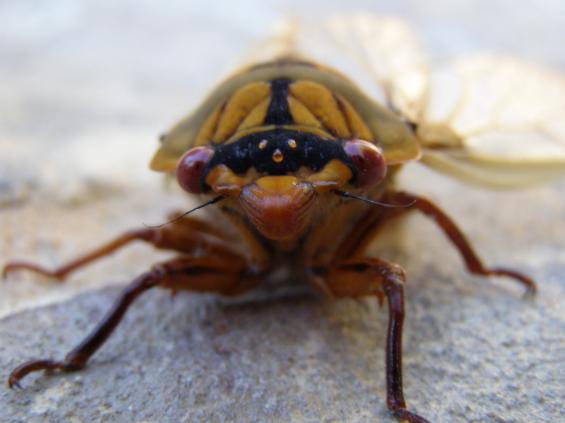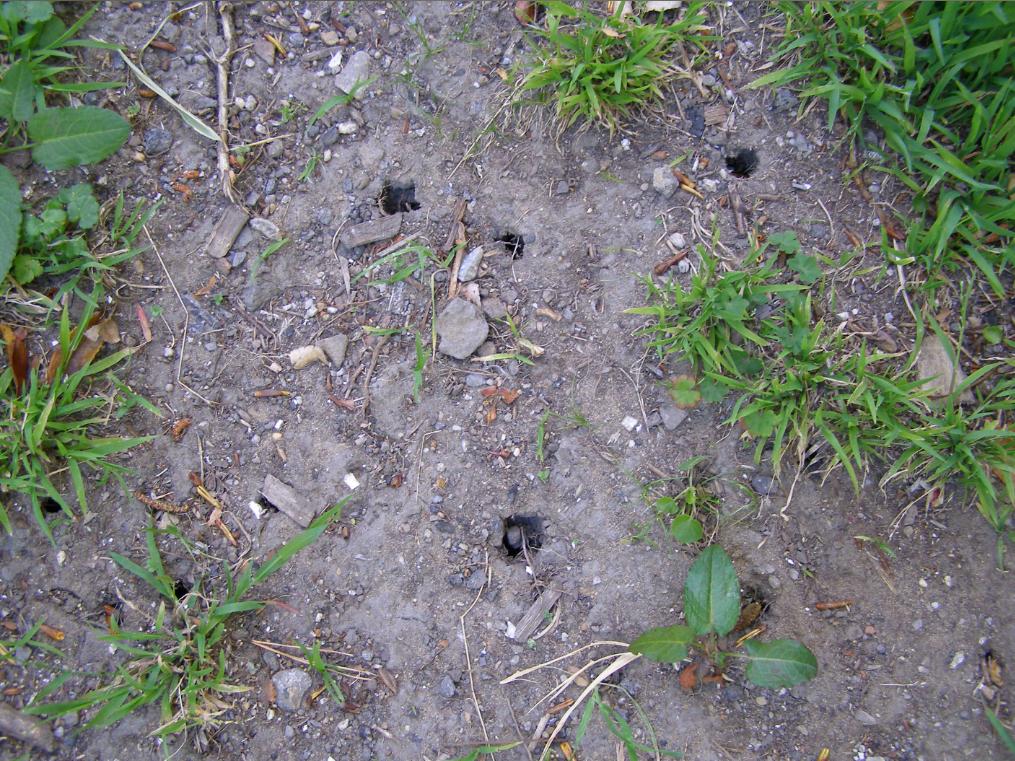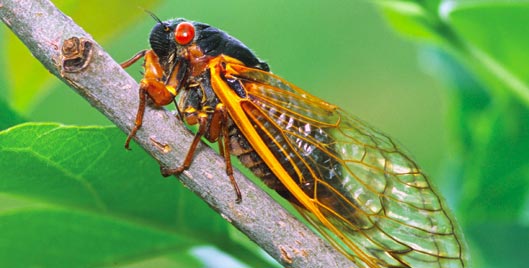Cicadas are back and it sounds like summer again
Sunday, September 29th, 2013 Yellow Monday Cicada (Cyclochila australasiae)
After seven years subterranean dormancy, they’re back chirping in the trees, and it sounds like summer again!
[Photo by Editor 20130928, photo © under ^Creative Commons]
Yellow Monday Cicada (Cyclochila australasiae)
After seven years subterranean dormancy, they’re back chirping in the trees, and it sounds like summer again!
[Photo by Editor 20130928, photo © under ^Creative Commons]
.
The shrill rhythmic cacophony of cicadas is one of Australia’s most memorable sounds of summer.
Cicadas are the loudest insects in the world and there are more than 200 species in Australia. The Yellow Monday Cicada (pictured above) is also commonly known as the Green Grocer (and formerly as the Great Green Cicada). It is about 4 cm long and has variants of colour, green or gold, but always with red compound eyes. It also has three simple eyes (‘ocelli‘) in the centre of its head, which are harder to see. These serve to help it to detect light intensity, its orientation to the sun, and are likely to assist in flight stability.
Cicadas spend nearly all their life dormant in nymph form sustained by imbibing sap from nearby trees, shrubs and grass roots underground.
In Australia, after about seven years and prompted by the onset of warm rainwater at or above 18 degree Celsius percolating down the soil, they emerge from the earth as pupae crawling vertically upwards. They leave mud tunnels to the surface which become signature holes in the ground. They climb above ground to safety, usually up the nearest tree.
.
 Cicada pupae mud tunnels, often in lawns below trees.
These are commonly mistaken to be Funnel Web Spider funnels.
Best NOT to put your finger down the hole to find out.
[Photo by Editor 20130929, photo © under ^Creative Commons]
Cicada pupae mud tunnels, often in lawns below trees.
These are commonly mistaken to be Funnel Web Spider funnels.
Best NOT to put your finger down the hole to find out.
[Photo by Editor 20130929, photo © under ^Creative Commons]
.
Here they metaphorphose into adults, shedding their exoskeleton (exuvia). The fully-winged adult cicadas emerge leaving their old empty nymphal skin behind and become capable of short flight. This all happens within days and hundreds of shed exuvia are commonly seen on tree trunks in gardens and bushland during the summer months.
A day or two passes for them to gain strength before they are able to climb into tree canopies and start their mating call. Metaphorphosis must be an energy sapping experience.
As adult cicadas, they only live for six weeks; fly around, mate, and breed over the summer, then die.
.
“We are like butterflies who flutter for a day and think it is forever.”
.
~ Carl Sagan (b.1934)
.
After mating, the female cuts slits into the bark of a twig, and into these she deposits her eggs. This can be repeated until she has laid several hundred eggs. When the eggs hatch, the newly hatched nymphs drop to the ground, where they burrow. The lifecycle of the cicada thus continues.
The lifecycle in Australia is generally seven years, but for some species can be as little as two years, or in some parts of the world up to seventeen years.
.
Cicada Chirping
.
The male circadas make loud shrill calls to attract females to mate. Each cicada species has a unique song to attract only its own kind.
The loud chirping calls of the male are heard over the summer months; harsh and high-pitched, these may reach 150 decibels. The sound is made by the rapid buckling of the timbal ribs, and amplified by resonation in an air sac; the frequency is around 4.3 kHz. Both male and female cicadas have organs for hearing. A pair of large, mirror-like membranes, the tympana, receive the sound. The tympana are connected to an auditory organ by a short tendon. When a male sings, it creases the tympana so that it won’t be deafened by its own shrill mating call.
Male mating calls typically occur during the day when sunny and at or above 18 degree Celsius, to compete to attract females.
The loudness of the cicada chorus is also thought to help repel predatory birds, probably because the noise is painful to birds’ ears interfering with their normal communication. The males of many cicada species, including the Greengrocer/Yellow Monday, and the Double Drummer, tend to group together when calling which increases the total volume of noise and reduces the chances of bird predation.
.
The Yellow Monday Cicada is naturally distributed from south-eastern Queensland through eastern New South Wales and Victoria to the Grampians, and through to Mount Gambier in south-eastern South Australia. It is common along the Great Dividing Range, and is also found in the Warrumbungles. It is commonly seen (and heard) around Sydney and Melbourne, the Blue Mountains and Gippsland. In Brisbane, it is only encountered at elevations above 300 m (1000 ft). It was associated with the White Stringybark (Eucalyptus globoidea) in a study at three sites in western Sydney.
Cicadas are so conspicuous that many of their common names were initially given to them by children. As a result cicadas probably have the most colourful common names in the insect world. Some of these include the Black Prince (Psaltoda plaga), Double Drummer, Floury Baker, and the Yellow Monday.
.
. An adult Cicada in habitat
[Source: ‘Festival of the Cicadas’, by Craig Vetter,
^http://www.chicagowilderness.org/CW_Archives/issues/spring2007/cicadas.html]
An adult Cicada in habitat
[Source: ‘Festival of the Cicadas’, by Craig Vetter,
^http://www.chicagowilderness.org/CW_Archives/issues/spring2007/cicadas.html]
.
.
“The world is full of magic things, patiently waiting for our senses to grow sharper.”
.
~ W.B. Yeats (b.1865)
.
.
References and Further Reading:
.
[1] The Australian Museum, ^http://australianmuseum.net.au/Cicadas-Superfamily-Cicadoidea
[2] ‘Greengrocer or Yellow Monday Cicada’, Climate Watch, ^http://www.climatewatch.org.au/species/insects/greengrocer-or-yellow-monday-cicada
[3] ‘Cyclochila australasiae’, ^http://en.wikipedia.org/wiki/Cyclochila_australasiae
[4] ‘Summer of singing cicadas’, by Owen Craig, ABC Science, ^http://www.abc.net.au/science/articles/2001/02/17/2822486.htm
[5] Moulds, M.S. 1990. Australian Cicadas. New South Wales University Press. 217 pp., 24 pls. (Also publications in 1992, 1994, 1996, 1998).
[6] ‘Cicada’, Wikipedia, ^http://en.wikipedia.org/wiki/Cicada
[6] Clyne D (1998). Cicada Sing-Song. Gareth Stevens Publishing, Milwaukee. USA.
[7] Ewart A (1990). Status of the Germar and Leach types of Australian cicadas (Homoptera) held at the Hope Entomological Collections, Oxford. Australian Entomological Magazine 17(1): 1-5
[8] Gwynne DT, Yeoh P and Schatral A(1988). The singing insects of King’s Park and Perth gardens. Western Australian Naturalist 17(2-3): 25-71
[9] Hill KG and Hill CE (1979). Acoustic behaviour of the bladder cicada Cystosoma saundersi. Australian National University Research School of Biological Sciences Annual Report – 1979: 122.
[10] Hayashi M and Moulds MS (1999). Observations on the eclosion of the hairy cicada, Tettigarcta crinita Distant (Homoptera: Cicadoidea: Tettigarctidae). Australian Entomologist 25(4): 97-101
[11] MacNally RC (1988). Simultaneous modelling of distributional patterns in a guild of eastern-Australian cicadas. Oecologia (Berlin) 76(2): 246-253.
[12] MacNally RC and Doolan JM (1986). Patterns of morphology and behaviour in a cicada guild: a neutral model analysis. Australian Journal of Ecology 11(3): 279-294.









